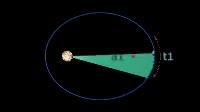Animation showing Kepler磗 laws of planetary motion. Kepler磗 three laws were published in 1609 first and second laws and 1619 third law. The first law states the the orbit of each planet is an ellipse, with the Sun at one focus. The animation shows the properties of an ellipse, the blue line: the Sun is at one focus, the pink dot shows the other focus. The foci are equidistant from the centre orange dot. The semi_major axis a is red. The lines joining the planet to each focus always add to a value twice that of the semi_major axis. Kepler磗 second law states that a line linking the planet to the Sun sweeps out an equal area in any given time. At its furthest from the Sun, an area a1 is swept out in time t1. Closest to the Sun, an area a2 is swept out in time t2. If t1 and t2 are the same time, the areas a1 and a2 are identical. This is because a planet travels more quickly closer to the Sun. The third law states that the cube of the semi_major axis of a planet磗 orbit red a is directly proportional to the square of its orbital period cyan P. The constant of proportionality is the same for any planet, so zooming out to show a more distant orbit, the same holds true: the cube of the semi_major axis purple a is proportional to the square of the period orange P. The eccentricity of the orbits has been greatly exaggerated for clarity _ in reality, the semi_minor axis of the Earth磗 orbit is 99.98 of the semi_major axis, making the orbit almost circular.
Details
WebID:
C00607637
Clip Type:
RM
Super High Res Size:
Duration:
000:46.000
Format:
QuickTime
Bit Rate:
24 fps
Available:
download
Comp:
200X150 (0.00 M)
Model Release:
NO
Property Release
No













 Loading
Loading